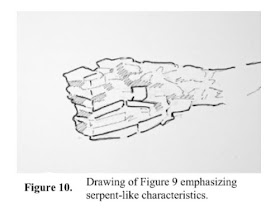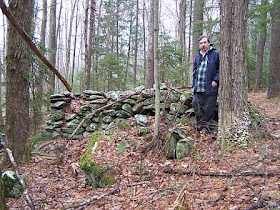While ignoring at least 13,000 years (97% or more) of the Human history of "New England"
Un-credited photo used in presentation
I don’t know how I
missed this one from last year (2021), a Zoom presentation by the man who “thinks
about stone walls more than anyone else:”
Harvard Stone Walls Mysteries Solved
“The Harvard Conservation Trust presents Dr.
Robert Thorson, as he decodes mysteries from the thousands of stones that make
up stone walls laid by colonists, Native Americans & enslaved people.
Thorson writes “[Stone walls are] a visceral connection to the past. They are
just as surely a remnant of a former civilization as a ruin in the Amazon rain
forest.” Professor Thorson reveals why New England is uniquely situated to be
the quintessential landscape for stone walls and the work that communities are
doing to preserve them.”
https://youtu.be/JAU2naemki4
About 46 minutes and 47 seconds into the presentation, we find that someone has sent in a photo of most of a "Stone Prayer," a Káhtôquwuk in the Mohegan/Narragansett/Pequot languages, a Kodtuhquag in Massachusett, as well as many other variants. These "stone heaps" have been documented by numerous early European visitors in the region who suggest a religious aspect to them that Indigenous People were reluctant to talk about. Thorson has chosen to rather facetiously label the photo as a
"Manitou Animal Effigy of a Turtle:"
"What is the meaning of facetiously?"
1. : joking or jesting often inappropriately : waggish. just being facetious. 2. : meant to be humorous or funny : not serious.

Thorson and Ives rail against "a collection of beliefs or practices mistakenly regarded as being based on scientific method" when it comes to the subject of "New England Stone Walls" and these "manitou animal effigy turtles" constructions while relying on folklore of, as Thorson puts it, a "Yankee Cowboy" transforming a howling wilderness, stone by stone, to farms and fields surrounded by "garbage piles of stones." Both write and lecture about the "dearth of scientific data" about "New England Stone Walls" while promoting the idea that the Indigenous Peoples of this corner of Turtle Island had to wait around for a superior advanced ocean going civilization from Europe to show up and teach them the art of stonework. I find that not much different that those beliefs promoted by Graham Hancock or Sir Wolter Scott that one can easily find on cable TV or a streaming service like NetFlix...
Both ignore (or openly ridicule) actual scientific investigation into similar stone structures and constructions such as those in Turners' Falls in MA, the Manitou Hussanash Preserve in RI, or the Oley Hills in PA, among other places. (Some examples: https://wakinguponturtleisland.blogspot.com/search?q=osl ) One of them, without embarrassment, even states on video that he has no desire to learn how to pronounce Indigenous Place Names. There's something about stones to be learned when one "decodes" what those words mean. Sometimes there's a stone - or a bunch of stones - in them.
So here's an Indigenous word for you that, as I said above, might explain the questionable "Manitou Animal Effigy of a Turtle" featured in the presentation:
Nohham
Rolf Cachat-Schilling (Mohawk-Nipmuc), writing in 2016 for the Massachusetts Archaeological Society, notes that “There
are several types of kodtonquagkash (kodtuhquag in Massachusett), including
effigies. Most kodtonquagkash are not
more than 2 m (6.56 feet) wide and less than 1.8 m. (5.9 feet) tall. They are usually made in an organized manner,
in several courses of stones, often turret-like in form atop a base
boulder. There are kodtonquagkash types
that are built directly on the forest floor, on shallow bedrock or even no rock
at all…At a site in Shutesbury MA, “94% of intact concentric circle káhtôquwuk
are formed from four to six rings, the center most often being a stone of unusual
type (jasper with contrasting line, pegmatite, quartz crystal or quartz
inclusion, leucic granite, or similar mineral). Center stone is usually quite
round or else pyramidal...88% of intact boulder-based cairn káhtôquwuk consist
of 38-50 flattish stones, usually all of the same type in a given feature,
where basal stones are somewhat larger than the succeeding courses of stone,
which are quite uniform in size. Courses of stone number five to seven in
intact specimens of this type…”
https://www.academia.edu/40876478/Quantitative_Assessment_of_Stone_Relics_in_a_Western_Massachusetts_Town
And, for goodness sakes, while there's no such thing as a "Manitou Animal Effigy of a Turtle," there do exist religiously, ceremonially stacked Turtle Effigies built on boulders (or about to be built on the bedrock of Bannock Point and other places by Indigenous People alive today), most likely Indigenous artwork that actually resembles actual Turtles here on Turtle Island, as it was called for thousands and thousands of years. Here's a rather famous one both are certainly aware of in Killingworth CT:
Quote from "Stone Prayers" by Dr. Curtiss Hoffman,
the photo from wherever I lifted it...
"The ages of the samples from Pratt Hill near Upton, Massachusetts, at a site that was recently desecrated by (stones) being scraped off the boulder foundation it was originally built on, are 1475-1375 C.E. (595 ± 50 years) for the top sample and 1315-1835 B.C.E (3,595 ± 260 years) for the bottom sample. These samples were obtained from dust or loess that had blown into the structure and collected in the scooped out hollow of the boulder foundation..."



















